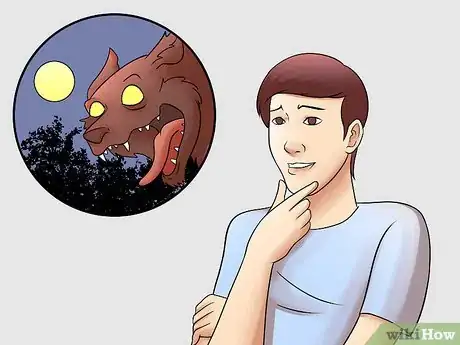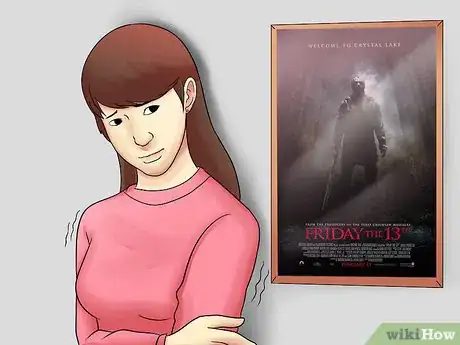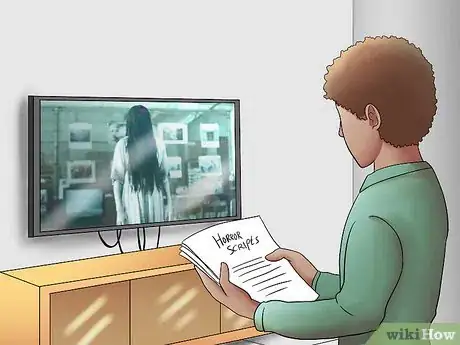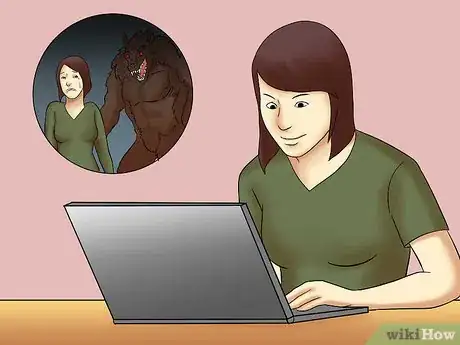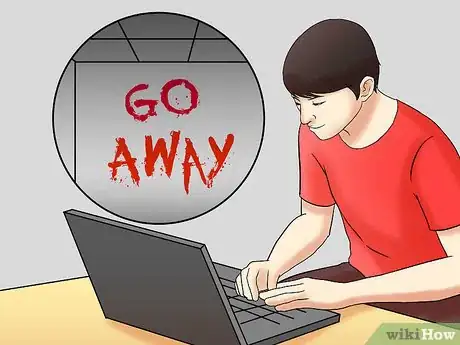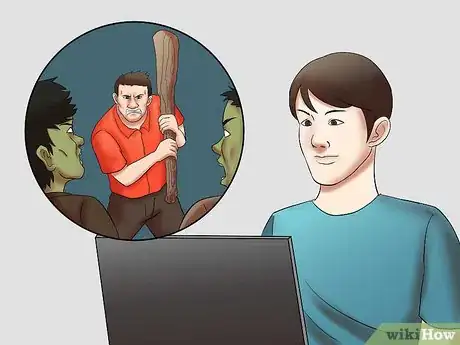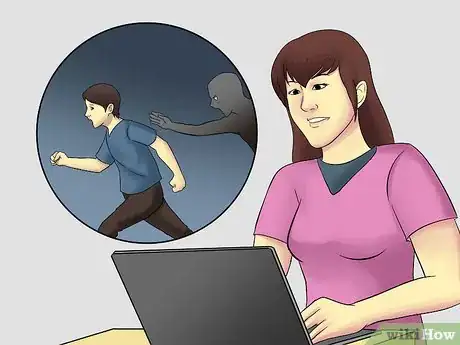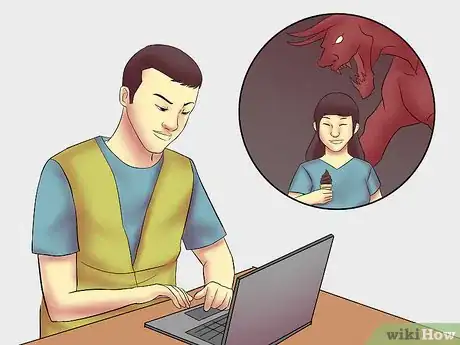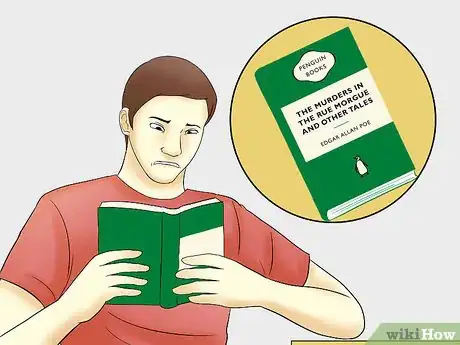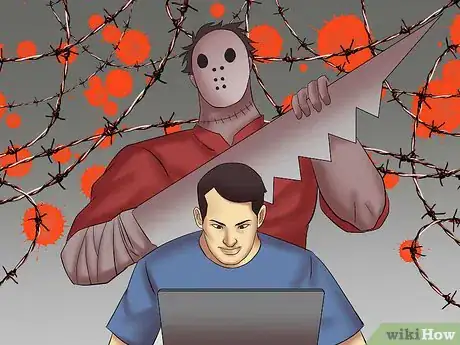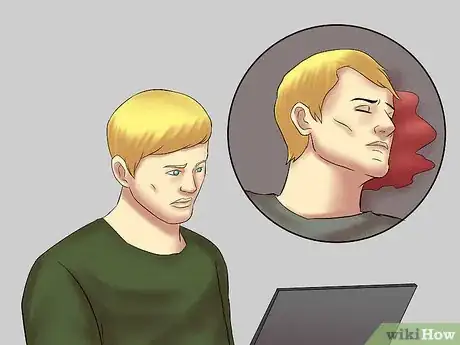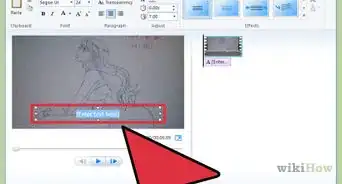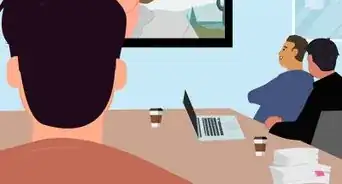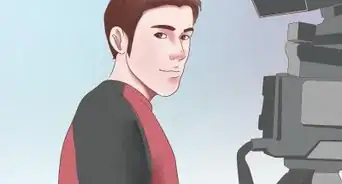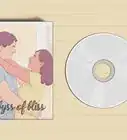This article was co-authored by Lucy V. Hay. Lucy V. Hay is a Professional Writer based in London, England. With over 20 years of industry experience, Lucy is an author, script editor, and award-winning blogger who helps other writers through writing workshops, courses, and her blog Bang2Write. Lucy is the producer of two British thrillers, and Bang2Write has appeared in the Top 100 round-ups for Writer’s Digest & The Write Life and is a UK Blog Awards Finalist and Feedspot’s #1 Screenwriting blog in the UK. She received a B.A. in Scriptwriting for Film & Television from Bournemouth University.
There are 13 references cited in this article, which can be found at the bottom of the page.
This article has been viewed 47,710 times.
Horror movies have long captivated our attention. Something about being scared silly draws people into theaters year after year, and horror classics like Night of the Living Dead and the recent It Follows are considered some of the best, socially relevant entertainment out there. Whether you want to make a gruesome slasher or a thoughtful thriller, writing a horror movie takes time, imagination, and a bit of research.
Steps
Finding Your Frightful Idea
-
1Find the core idea -- a villain, setting, or gimmick-- that will make your film unique. Horror films are largely formulaic when it comes to structure, but the best horror movies have an element that sets it apart from the rest. This core idea will be the foundation of your entire script, but it is also the hardest thing to come up with. However, you do not need to reinvent the entire genre -- one little thing to make your movie enough is often more than enough:
- Paranormal Activity is a classic haunted house movie, but it is fully shot by webcams and security footage, giving it a unique look and feel.
- You're Next turns a basic serial killer movie on its head by making one of the "victims" a better killer than the supposed villains.
- Scream would be a basic slasher film, but the characters' unique knowledge of horror film "rules" was so inventive it spawned four sequels and endless imitators.
- Even changing the setting alone can be enough to make a movie unique. 30 Days of Night is a basic vampire movie, but it's set in Alaska, where night lasts a whole month.[1]
-
2Tap into your own fears for inspiration. There are many possible reasons why we love being scared, but one of them is the communal connection people have over their deepest fears. The fear of the dark, fear of death, and fear of losing our loved ones are deep, universal fears that will naturally work into your script. However, the king of all of these fears, and of all fear, is the fear of the unknown. What times in your own life have you been confused and terrified? The things that scare you will scare other people, so feel free to tap into your own life and fears for inspiration.[2]
- What horror movies scare you? What scenes do you still remember?
- When have you been scared lately? What is it that really scared you, and how can you replicate that fear in others?[3]
Advertisement -
3Watch horror movies and read horror movie scripts. Just like any other artist, you need to study from the best to learn from the best. Take time to watch horror movies regularly, then read the screenplays (found online with a quick search) of your favorite movies.[4] While you're studying, take notes on the following:
- How does the writer create tension on the page without music or actors?
- Is the screenplay itself scary?
- How do you format scares and different, tense scenes?
- At what page or minute does each scare occur?
- What parts fail, and how would you fix them? What parts succeed, and why?[5]
-
4Understand scriptwriting format. Luckily, there are hundreds of resources and programs that will automatically format your script into the right format for you. Still, you need to know how to create a professional looking script if you ever want your movie to be made. The format is not arbitrary -- it is made to make shooting and planning the movie easy for everyone, and you'll find it comes naturally after some practice.
- Celtx and Writer Duets are free programs with auto-formatting for scripts. If you want to write professionally, you should consider buying Final Draft Pro, the industry standard scriptwriter.[6]
-
5Sketch out your five main plot points. Every horror movie ever made follows a simple but highly customizable format. Unless you have a really good reason to break it, the following format will help you quickly draft up your movie for the best pacing. Use this structure to build the skeleton of your movie, then make it unique in the individual scenes:[7]
- Beginning: Open on a scary event. This is usually the villain's first victim-- the murder or event that sets the movie in motion and shows the villain's "style". In Scream, for example, it is Drew Barrymore's character and boyfriend getting murdered.[8]
- The Set-Up: Who are your main characters, and why are they in this "horrible" place? The teens might head to the Cabin in the Woods, or the family moves into the creepy old house in Amityville. Either way, we get to know the future "victims" of your script. The villain or evil may be present, but is lurking in the background. This is the first 10-15% of your movie.
- The Warning: Roughly a third of the way into the script, a few characters realize that not everything is as it seems. Many of them will ignore or miss the signs, but the viewer knows that the evil is growing around them.
- The Point of No Return: The characters realize they are stuck in this horror. The first character dies, the villain appears, or they get literally trapped, like in The Descent. There is no more ignoring the danger. This is usually halfway through the story.
- The Major Set-Back: At 75% or so, the characters believe they have won. Suddenly, however, the villain comes back even stronger than before. This false sense of security lulls the characters into near-certain doom.
- The Climax: Your main character(s) makes a final push to survive by escaping or defeating the villain. The adrenaline is high, and you need a climactic fight/scare/moment to cap everything off.[9]
- The Resolution: All is well, and the main character has survived. The villain appears dead, and everything is good again... at least until the sequel or very ending, when evil often resurfaces (Drag Me to Hell, V/H/S).
Writing Horror Structure
-
1Kick the script off with a scare or significant moment of tension. This is the classic way to open up a horror film, as it preps the audience for what is to come and unsettles them early on. The best horror movies scare viewers even when nothing bad is happening because the opening scene makes them aware of the evil lurking around the corner. Use this first scene to prime the audience for future scares. It shouldn't be the most terrifying moment in the movie -- just enough to make them curious or worried.[10]
- The Exorcist's opening isn't the scariest thing in the world, but the odd, primordial location hints at the ancient, malevolent demon that lurks underneath the surface throughout the movie.
- Scream boasts one of the most famous, and chilling, openings in horror history. It is basically a short film showcasing the killer's first villain. Writer Kevin Williamson gives us everything -- tone, gore, humor, and terror -- while showing us that no one is safe.
- There are exceptions to this rule. Cabin in the Woods starts mundanely in an effort to lure the viewer into a false sense of security, for example.
-
2Build sympathy for at least one character for the first 10-20 pages. For maximum frights, you need the audience to care about the characters and their fate. If they don't then the eventual deaths will ring hollow and you won't get great scares as a result. All of the best horror movies have the best characters, not just a good villain. Take some time to let your characters converse and hang out before the evil really takes hold -- it will pay off later.
- The Poltergeist takes its time making you feel for the "average American family" at the core of it, making their later terrors feel like they could happen in anyone's home, anywhere.
- Nightmare on Elm Street spends a good 15-20 minutes at the kid's school, then another few minutes at a standard slumber party, building up sympathy for the main characters.
- You're Next goes the opposite direction, setting up the dysfunctional, annoying, manipulative family at the heart of the movie so that you root for the killers (who are being hunted) by the ending.
-
3Ratchet up the tension slowly. The best scares come later in the movie, when your audience is primed and already on the edge of their seat. This is your biggest challenge while writing -- building tension carefully without boring the audience or numbing them to the scares. The easiest way to do this is to defy expectations. Remember -- viewers are often more scared by what they don't see than what they do. Use the fear of the unknown to your advantage. Once you've set up characters and setting, start to break the norm -- moving furniture, missing characters, odd signs/signals, ominous news bulletins, etc. Again, watching the experts will help you:
- The Conjuring doesn't kill a single person, yet is considered by many a modern classic. The tension comes from what is not on screen. When you see the shaking cabinets, shadowy feet, and hear strange noises, the viewer's imagination does all the work for them.
- Halloween succeeds largely because we don't know where Michael Myers is at any time. He could be behind any corner, in any room, because the writer wisely leaves him in the background in order to build tension. Because he so rarely "jumps out," we never know when to expect him.[11]
- Many horror films rely on "jump scares," when a loud noise or quick jump startles the viewer immediately. However, modern movies are using "fake" scares to build tension, having good guys (or pets) pop out to lull the viewer into a sense of security.
-
4Unleash the horror halfway through the movie. Your first big kill is going to kick the last two-thirds of the movie into high gear. This almost always needs to be a major character, and the death indicates to the characters, and the viewer, that there is no turning back now. Everyone is in grave danger, and all of the audience's worst fears have come to fruition. This scene needs to be scary, a big payoff from the prior minutes of tension building, so work on making this scene stand out.
- It is often best to imagine this moment as a mini-movie with a beginning, middle, and ending. Think of one specific scare and then work backward to make the scene shine.[12]
-
5Let your protagonists start to pull ahead, then chop them back down to size with roughly 25% left to go. Give your characters a glimmer of hope after the first major death. While things are terrible for a while (another character or two often dies between this moment and the first death), eventually the main character(s) get a grip on the situation. They decide to escape, or fight back, and they start to succeed too... until the villain cuts their plans short at the last minute.
- The Night of the Living Dead has a tense, action-filled attempt at escape, a chance to get everyone out of the farmhouse. The characters even make it to the car, and avoid all the zombies, until their rushed, faulty plan literally blows up in their face.
- Shaun of the Dead, a horror-comedy that sticks to horror structure, finds the main characters successfully boarded up until one of their greedy friends lies about being bitten.
-
6Close everything up with a climactic showdown or scare. At least one character needs to escape from the failed plan, and they must make one final, last-ditch effort to survive. Depending on your movie, you can take this in multiple directions, but, in general, the characters either decide to run away or fight back the evil.
- Funny Games' main character decides, despite her hatred for the villains, that all she can do is run. What follows is a tense, cat & mouse scene of hopeful escape.
- Dawn of the Dead finds the desperate survivors willing to fight for their freedom, taking the battle straight to the zombies instead of waiting.
-
7Provide the audience some semblance of resolution. By the end of the move, you need to reveal the killer (if it is another character), and you need to show whether or not the main character has triumphed. Commonly, the main character triumphs over the evil, only to be taken by surprise at the very end of the movie, like in Drag Me to Hell and Nightmare on Elm Street. Sometimes the main characters are killed, but there is a hint that the villain is not actually dead. No matter what your ending is, you need to provide the audience some closure, even if you imply that things are still dangerous.[13]
Improving Your Script
-
1Let the atmosphere, tension, and fear come through on the page. You cannot just say, "It will be scary when it is on a screen." A terrifying scene must be terrifying on the page as well, building suspense that helps the directors, producers, and actors see where the scene is coming. Make the screenplay scary, tense, and atmospheric and the movie will be full of frights.
- Read horror writers like Edgar Allen Poe and Stephen King to learn about creating tension through words alone.
- You may have to bend some screenplay conventions to build a tense, terrifying scene on the page. Remember, however, that your first goal is to write a script that accurately portrays the movie that is eventually made.[14]
-
2Keep things as real as possible. Horror already pushes the limits of "suspension of disbelief," so don't give your viewers any additional reasons to push the script away. Characters should act realistically, meaning they are afraid for their lives and don't make obviously dumb mistakes like following the killer or ignoring warning signs. The killer should be overpowering, but not so much so that you can't root for the protagonists to ultimately win (even if they don't). Finding realism in horror is mostly about writing realistic characters, but a generally consistent, realistic world, even if it is clearly fictional, will help your scares hit harder.[15]
-
3Spend time on 1-2 big, original, showstopping scenes, usually deaths. Horror movies live and die based on their signature scenes. Scream is a great movie, but even if it wasn't the opening death would be enough to keep it famous. A great, memorable death will be the signature scene of your movie, and what helps readers remember it for years to come.[16]
- The entire Final Destination series is built on 4-5 of these moments each movie. While the don't always work, each one has at least one death that viewers will never forget.
- Psycho is a great movie, but without the shower scene it likely would have fallen out of collective memory years ago. The scene was so jarring, so surprising, that it is still discussed and satirized today.[17]
-
4Toss some humor into the script. No one wants to sit in pure tension for two hours, and this ultimately makes the movie's later scares less effective. There is a good reason horror and comedy are so commonly mixed, and that is because they are two sides of the same coin -- surprise. Let a few jokes ease the tension, helping your audience relax here and there while still sitting on the edge of their seat. Humor is also a great way to give a false sense of calm, making the next scare hit even harder.
- Pure tension gets old, and eventually doesn't feel tense anymore. Try placing a joke or two shortly after a big scare scene early in the movie. This helps the audience "get over" the rush of the first scare, letting you start building tension again for the next one.[18]
-
5Listen to horrifying music while you work. This doesn't mean you should put Vanilla Ice on. Find horror soundtracks and play them in the background while you write, creating the atmosphere of tension as you work. You can always work in silence as well, but for those looking for a little creative kick you can't go wrong with the Halloween or The Conjuring soundtrack.[19]
Community Q&A
-
QuestionHow do I start a horror movie?
 Peyton PhippsCommunity AnswerBrainstorm first. Think about a setting, an antagonist and a protagonist. In this case, the antagonist is the demon or whatever scary thing/person you want it to be. The protagonist should be the person who's dumb enough to go in the basement (example) or the person who is not scared.
Peyton PhippsCommunity AnswerBrainstorm first. Think about a setting, an antagonist and a protagonist. In this case, the antagonist is the demon or whatever scary thing/person you want it to be. The protagonist should be the person who's dumb enough to go in the basement (example) or the person who is not scared. -
QuestionHow can I perfect my horror story, and to make it even more scarier to everyone, and then work on the effects of the scenes?
 Julia WickCommunity AnswerThink about what makes you scared. If you are afraid of someone breaking in like ‘the purge’, try to make your actors breathing hard and the purgers slowly sneaking behind them. Add lights, music and imagine how you would feel if your script was real.
Julia WickCommunity AnswerThink about what makes you scared. If you are afraid of someone breaking in like ‘the purge’, try to make your actors breathing hard and the purgers slowly sneaking behind them. Add lights, music and imagine how you would feel if your script was real. -
QuestionI'm making a horror stop motion movie of my favorite toys and the protagonist is a paper doll. Is this okay?
 ToniAjoneenCommunity AnswerFirstly, very original. Secondly, horror movies involving innocent toys becoming... not so innocent is a great idea! Go for it and let your imagination run free. Also, a little tip about age groups: If the age group your movie is intended for is under at least 11, be careful about language, graphic violence, etc.
ToniAjoneenCommunity AnswerFirstly, very original. Secondly, horror movies involving innocent toys becoming... not so innocent is a great idea! Go for it and let your imagination run free. Also, a little tip about age groups: If the age group your movie is intended for is under at least 11, be careful about language, graphic violence, etc.
Warnings
- Be sure your actors are trained, especially if you use dangerous items like firearms and explosives.⧼thumbs_response⧽
Things You'll Need
- Trained actors.
- A director.
- A camera-man.
- An executive producer.
- Creativity.
References
- ↑ http://terribleminds.com/ramble/2011/10/11/25-things-you-should-know-about-writing-horror/
- ↑ http://thescreenplaywriters.com/screenwriting-tips/how-to-write-a-horror-movie
- ↑ http://filmmakermagazine.com/76622-so-you-want-to-make-a-horror-film-on-jump-scares-and-other-basics-of-fright/#.VjJ8uis4nEY
- ↑ Lucy V. Hay. Professional Writer. Expert Interview. 16 July 2019.
- ↑ http://nofilmschool.com/2013/10/how-to-make-your-horror-film-screenplay-more-effective
- ↑ http://filmmakermagazine.com/76622-so-you-want-to-make-a-horror-film-on-jump-scares-and-other-basics-of-fright/#.VjJ8uis4nEY
- ↑ http://blog.karenwoodward.org/2013/06/how-to-write-horror-story.html
- ↑ http://www.nefariousfilms.com/screenwritingworkshop.html
- ↑ http://www.storymastery.com/story/screenplay-structure-five-key-turning-points-successful-scripts/
- ↑ http://filmmakermagazine.com/76622-so-you-want-to-make-a-horror-film-on-jump-scares-and-other-basics-of-fright/#.VjJ8uis4nEY
- ↑ http://www.simplyscripts.com/WR_HH_horror.html
- ↑ http://www.simplyscripts.com/WR_HH_horror.html
- ↑ http://www.simplyscripts.com/WR_HH_horror.html
- ↑ http://nofilmschool.com/2013/10/how-to-make-your-horror-film-screenplay-more-effective
- ↑ http://thescreenplaywriters.com/screenwriting-tips/how-to-write-a-horror-movie
- ↑ http://terribleminds.com/ramble/2011/10/11/25-things-you-should-know-about-writing-horror/
- ↑ http://terribleminds.com/ramble/2011/10/11/25-things-you-should-know-about-writing-horror/
- ↑ http://www.raindance.org/13-steps-to-making-a-horror-film/
- ↑ http://www.raindance.org/13-steps-to-making-a-horror-film/
About This Article
If you want to write a horror movie, start your script with a moment of tension or fright to unsettle your audience. For inspiration, think of the opening scenes of your favorite horror movies, like Scream. Next, create a feeling of sympathy for one of the main characters, because your audience will feel more frightened if they’re engaged with the plot. Then, build up to a scary scene, which could involve one of the main characters dying. In the last part of the script, give your audience a false sense of security before allowing the villain to strike back even more terribly. For tips on how to format your script and how to come up with a soundtrack, read on!
